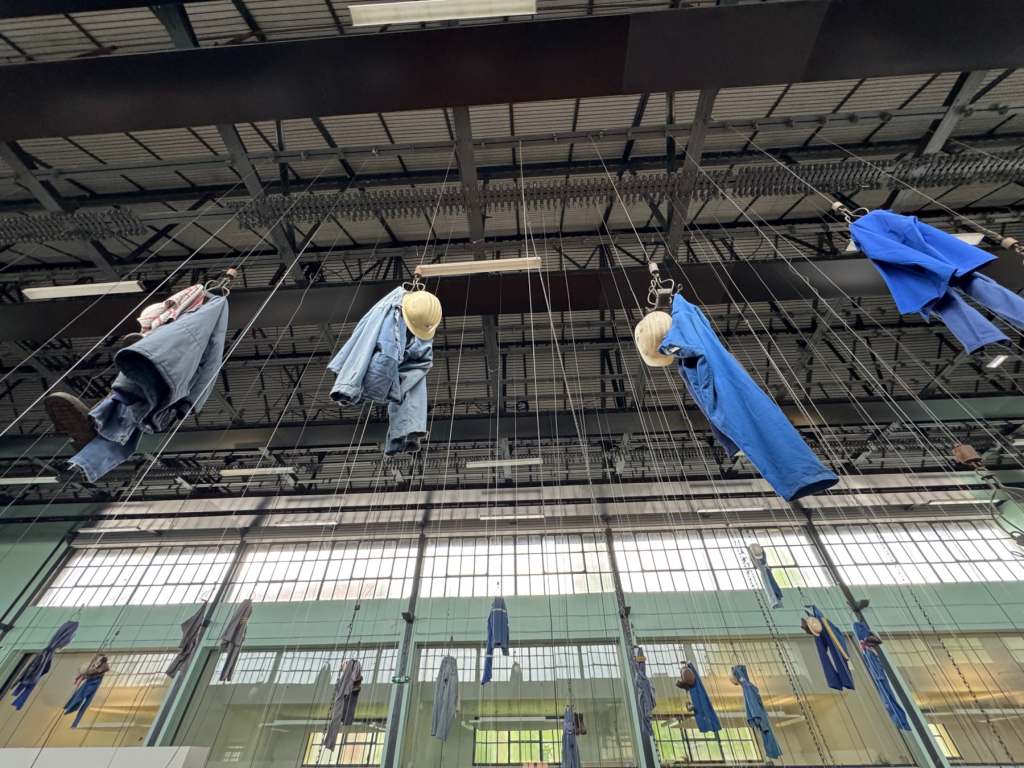Mark Bibby Jackson explores the remarkable transformation of France’s former coal capital, Lens with its magnificent Louvre Lens Museum.
Is it my imagination but I sense the scent of iron still lingers in the air as I arrive in Oignies, on the outskirts of Lens in northern France. It’s not the acrid tang of industry, but something softer, seeping from the bricks of the 9-9bis Mining Pit, where my 48-hour journey into the soul of this reborn region begins.
Once the beating heart of the Pas-de-Calais coal industry, 9-9bis is no museum relic but a vibrant cultural centre. Like Zeche Zollverein in Essen, Manufaktura in Łódź, or Katowice, all of which I have recently visited, it’s a living testament to how industrial scars can be reshaped into spaces of creativity and community, given the right direction and recognition. The Nord-Pas de Calais Mining Basin received UNESCO’s recognition in 2012 “as a landscape shaped over three centuries of coal extraction”.
Day 1: 9-9bis Mining Pit
Coal was first discovered in the region in 1820, but it was Henriette de Clercq who uncovered the crucial seam in 1842, triggering the birth of the ninth shaft — the “9” in 9-9bis. At its peak, 2,400 miners descended into the earth daily.
However, it’s what has happened since the mine’s closure in 1990 that truly inspires. Saved from destruction in 2003 when the local conurbation bought the site for a symbolic €1, the area has been reimagined as a musical and artistic hub. There are now six recording studios — anyone can hire one for just €15 an hour, a bargain compared to Lille or Paris.
I start in the changing room, where hooks still dangle from the ceiling in a clever pulley system that once kept work clothes out of reach and out of the way. A contemporary art exhibition explores the environmental legacy of mining — how tools altered landscapes, polluted soil and air, and yet, remarkably, how nature now reclaims it all. Green shoots grow defiantly through clay and ash. Terrils — those great black slag heaps — are now nature trails.
Inside Le Métaphone, local school groups gather to explore sound. Some nights, this place draws over a thousand visitors for festivals ranging from brass bands to heavy metal. They even honour Saint Barbara, patron saint of miners, each November with a candlelit procession.
Hotel Louvre-Lens
As evening falls, I check into the Hotel Louvre-Lens — a beautifully converted set of miners’ cottages. The hotel is a thoughtful blend of history and contemporary design, echoing the same quiet reinvention I’ve witnessed all day.
Dinner is at the hotel’s Le Galibot. I start with a chilled gazpacho, vibrant and full of depth, before moving on to a delicate fillet de lieu — black pollack, cooked perfectly.
The staff are incredible, reacting to a minor medical emergency of no fault of their own with efficiency and cordiality. Nothing seems too much for them to ensure our visit is a positive one.
Louvre Lens Museum
After breakfast, I head to the Louvre-Lens Museum, just across the road from the hotel.
Built on the site of a former minehead, the museum opened in 2012 (the same year as the UNESCO listing), with a bold vision: to make world-class art accessible to everyone, especially the people of this working-class town. The museum works closely with the community of which it is very much a part.
The architecture of the Louvre Lens Museum is striking; glass and aluminium, sleek and modern. You still see remnants of the old industrial site. It reminds me of Katowice, where I watched street art blossom from the soot of Silesian industry.
Inside, the Gallery of Time unfolds like a river of human history, from the 3rd millennium BC to 1850.
There are no walls between eras or regions — just a clean, flowing timeline from Mesopotamian carvings to Renaissance portraits. It’s chronological, not thematic, offering a fresh take on how we interpret the past. The curation is light and elegant, clearly designed with the visitor in mind. And crucially, many labels include commentary from local residents, grounding the art in the community.
There’s no permanent collection. Instead, pieces from the Louvre’s vaults in Paris rotate, offering exposure to works otherwise rarely seen. On this visit, a 15th-century chess set catches my eye — and my mother’s imagination.
I love the Four Seasons by Giuseppe Arcimboldo, in which we can see nature itself fading with time. Goya’s portrait of Luis Maria de Cistue with his dog mesmerises me. Apparently, the pink band the child is wearing inspired Yves Saint Laurent.
The iconic fashion designer is one of many whose creations are on display at the temporary exhibition on The Art of Dressing: Dressing Like an Artist. Totally lacking in sartorial elegance myself I find the exhibition intriguing. Standout creations include ethereal gowns by Christian d’Or.
Terrils 11-19
After checking out of the hotel, we drive to the terrils 11/19, twin slag heaps that rise like pyramids just outside the town.
We lunch at a local place on a roundabout in Loos-en-Gohelle, a suburb of Lens, where the terrils are situated. I ponder whether we are the only tourists to experience this community experience.
The terrils were once mine shafts 11 and 19, but now the area is a vast green park, part hiking trail, part historical site. The climb is manageable and utterly worth it. From the summit, the view stretches across Lens and beyond. You can see the museum, the football stadium, the softened edges of once-fierce industry.
I am told the UNESCO World Heritage designation helped transform the perception of the region. It was no longer regarded as dirty and undesirable, but a testament to the past with a hope for the future. Lens isn’t just preserving history — it’s letting it breathe, evolve and belong. It is a wonderful example of the transformative potential of our rich industrial heritage, so long as it is embedded within the community.
DFDS Ferries
Our return ferry to France was with DFDS, from Dover to Calais and back again. We opted for priority boarding and the premium lounge, which is ideal if travelling with an elderly companion. Once we arrived in Dover we decided to sail to Dunkirk instead, and the staff arranged this without hesitation, speeding up our overall journey time. As always the sailing was comfortable and all too brief.
Things to Do in Pas-de-Calais France
To discover all the things to do in Pas-de-Calais France, visit the local tourism website. Or to learn more about the mining heritage in the Pas-de-Calais, click here.

